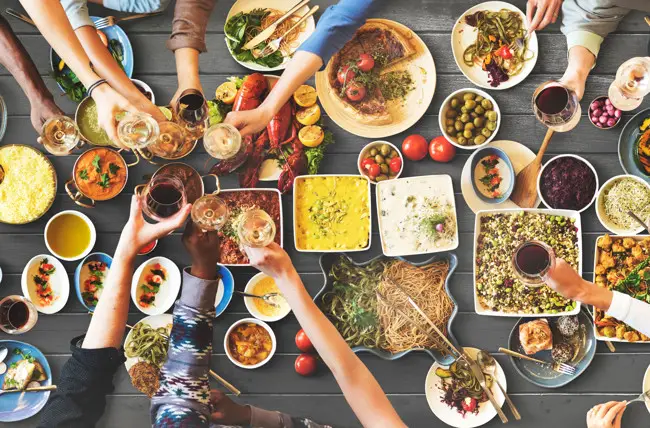For parents today there is an overwhelming amount of information available on what we should and should not be eating. The everyday job of grocery shopping or planning meals for our families is a maze of choices. One food group we hear a lot about is processed foods. But what exactly are processed and why are they bad for us? Nutritionists, dietitians, and doctors share what you need to know about processed foods, and what you can do to limit the amount of processed foods your family eats.
First, let’s clear things up. Processed foods are defined as any foods that have been changed before they reach the consumer, according to the Academy of Nutrition and Dietetics. Unless you grow and raise all of your own food, this means almost everything.
“All foods undergo some level of processing. The level falls on something of a spectrum, from minimally processed to more heavily processed,” says Malina Malkani M.S., R.D., C.D.N., registered dietician nutritionist and spokesperson for AND. “To call all processing unhealthy is a bit of a misnomer.”
Processed foods typically fall into 1 of 5 categories:
- Minimally processed: prepared fruits and vegetables, bagged salads, nuts, and coffee
- Processed to preserve freshness at harvest: canned food, frozen fruits and vegetables, and jarred purees
- Packaged foods with added ingredients to improve vitamin content, taste, color, texture, and shelf life: rice, jarred tomato sauce, and boxed pasta and mashed potatoes
- Ready-to-eat foods: soda, cereal, snack foods, deli meats, yogurt, and ice cream
- Pre-made meals: toaster pastries, microwave meals, and frozen pizza
The healthiest foods are whole foods and those on the minimally processed end of the scale. The unhealthiest are the hyper- or ultra-processed foods, which are “foods that really don’t resemble their original state and have a lot of ingredients, a lot of additives,” says Sally Kuzemchak, M.S., R.D., author of The 101 Healthiest Foods for Kids and founder of RealMomNutrition.com.
Processed Foods Are Low in Nutrients, High in “Bad” Stuff
A high intake of ultra-processed foods has been linked in studies to obesity, diabetes, high blood pressure, heart disease, and cancer, according to BMJ Open, American Institute for Cancer Research, and National Institutes of Health. “The more heavily processed foods tend to be higher in the nutrients that we want to limit, namely added sugars, sodium, saturated fat, and artificial trans fat,” Malkani explains. “These, when eaten in large qualities over time, do lead to more detrimental health effects.” Yet because these foods are convenient and taste good, we eat a lot of them.
A 2016 study published in BMJ Open revealed that ultra-processed foods make up more than half of Americans’ diets. The same study found that as we eat more of them, we consume fewer essential nutrients (protein, fiber, vitamins, and minerals) and more added sugar, salt, carbohydrates, and saturated and trans fats overall.
Because they contain very little protein, fiber, and whole grains, ultra-processed foods can be unsatisfying. This means you eat more than you should, and are more likely to go over the recommended daily allowance of salt, sugar, and saturated and trans fats.
The Hidden Additives in Processed Foods
In July 2018, the American Academy of Pediatrics made a statement warning of the dangers to children of chemicals from additives, colorings, preservatives, and packaging of many processed foods. These include artificial colors in foods, preservative nitrates (found in processed meats), and BPA, phthalates, PFCs, and perchlorate in packaging.
“There are critical weaknesses in the current food additives regulatory process, which doesn’t do enough to ensure all chemicals added to foods are safe enough to be part of a family’s diet,” said Leonardo Trasande, M.D., M.P.P., F.A.A.P. “As pediatricians, we’re especially concerned about significant gaps in data about the health effects of many of these chemicals on infants and children.”
Small Steps to Limit Processed Foods Have Big Impact
Experts suggest doing the following to reduce the amount of processed foods you and your children eat:
- Choose the products with the fewest ingredients. “The lower the amount of ingredients, usually the better,” says Natalie Monson, R.D.N., C.D., registered dietitian and co-founder of Super Healthy Kids. Anything with a long list of ingredients you cannot pronounce means it’s ultra processed.
- Pick whole grains. Even if the front of the package says whole grain, check the ingredients for refined or enriched flours. These are white flours stripped of their nutritional value.
- Read the ingredients list. “Ingredients are listed in descending order by weight. If you look at the first three and they are white flour and sugar, then you know that these are going to predominantly make up the food,” Malkani says.
- Avoid artificial colorings. Studies have linked them to behavioral problems in some children. While the effects aren’t seen in all kids, there are plenty of natural options.
- Don’t eat processed meats, especially when pregnant. Unless marked nitrate-free, nitrates—a known carcinogen—are used as preservative.
- Check how much of the recommended 2,300mg of sodium a day a product contains. “The vast majority of our sodium comes from processed foods and restaurant foods, only ten percent comes from the salt shaker,” Kuzemchak says.
“A quick tip is to compare grams of sodium and calories,” says Bridget Murphy, M.S., R.D., registered dietitian at Hassenfeld Children’s Hospital, NYU Langone. “If a food has more grams of sodium than calories, it’s probably very salty.”
- Beware trans fats, which are listed as hydrogenated or partially hydrogenated oils. Since the U.S. Food and Drug Administration announced in 2015 that trans fats were “not recognized as safe,” food companies are being forced to remove them. But it will be several years before all of the foods that contain those oils disappear from circulation. If a product has 0.5g of trans fat or less per serving, manufacturers can round down to zero, so it’s important to look at the ingredient list, not just the nutrition label.
- Look for added sugar. Government dietary guidelines recommend consuming no more than 10 percent of our daily calories from added sugars. There are many different names for sugar, including natural sounding ingredients such as honey and maple syrup. By 2021 manufacturers will have to list added sugars on labels to make it easier for us to identify them. To keep your daily consumption on track, a trick is to remember that 4 grams equals 1 teaspoon. Children should only be eating 6-11 teaspoons a day, depending on their age.
A good rule? Choose processed foods that are higher in fiber and protein, and lower in sodium, sugar, and saturated fat, Malkani says.
Finding a Balance
If cutting out ultra-processed foods seems like a daunting task, don’t panic—it isn’t necessary to avoid them completely. “I don’t think you should have hard rules surrounding foods. There are different options that are definitely healthier for us. Try to eat the majority of your foods as whole foods, but you really can’t avoid processed foods,” Monson says.
A practical tip is to use Murphy’s 70-30 rule. “If seventy percent of our food is high antioxidant food, so high protein, good vegetables, lots of vitamins and minerals, then [it] will be able to take care of the thirty percent of the ‘bad’ diet,” shes says.
By feeding your family nutrient-dense foods you’ll automatically reduce the amount of processed foods they eat, without having to obsess. “All meals and snacks should have a variety of the main food groups,” Monson suggests. “A grain, a fruit or vegetable, and a protein. If you do that it becomes less of a big deal because they are getting that other nutrition.”
Remember: Every day doesn’t need to be perfect. It’s all about creating a healthy food environment at home, not banning foods. “Ultra-processed foods are everywhere and kids need to exist in a world that has them because they’re not going to go away,” Kuzemchak says. “Denying your kids sets them up to want them even more. When they have their own money in their pocket, when they have some freedom, they’re going to seek out those foods. There is research to back up that for certain children, if you deny them certain types of food, when you present them with those foods then they will overeat them. ”
As Pulitzer Prize-winning investigative reporter Michael Moss said in his book, Salt Sugar Fat: How the Food Giants Hooked Us: “They may have salt, sugar, and fat on their side, but we, ultimately, have the power to make choices. After all, we decide what to buy. We decide how much to eat.”





















